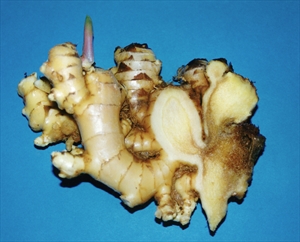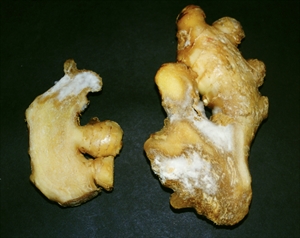Fusarium yellows
Pacific Pests, Pathogens and Weeds - Online edition
Pacific Pests, Pathogens & Weeds
Ginger Fusarium yellows (292)
Fusarium oxysporum f.sp. zingiberi. The f.sp. stands for 'special form'. It means that the fungus is similar in appearance to other Fusarium oxysporum fungi, but it differences genetically and only infects ginger.
Asia (India and China), North America (Hawaii), Oceania. It is recorded from Australia and Hawaii, and there are unconfirmed reports that it is present in Fiji.
It is specific to ginger.
A fungus causes the damage. Plants infected by Fusarium yellows show symptoms in three ways:
First, a fast developing rot occurs if the fungus is in the seed piece (called the rhizome), that prevents 'germination' of the shoots, or the shoots are very weeks and soon die.
Second, if the plant survives this early rapid rotting or the seed piece becomes infected through cracks or wounds, symptoms develop more slowly. Plants become stunted and yellow, beginning with the lower leaves, which dry out. Over a period of several months the disease progresses to the other leaves causing similar symptoms and premature death of all above-ground parts. Below ground, the rhizome becomes shriveled with a brown or black internal rot of the outer layers, and a creamy-brown colour of the water-conducting parts (Photos 1&2). Finally, all that is left of the rhizome is a shell and fibre.
Third, it is common to see white cottony growth of the fungus on rhizomes in storage or on those sold in stores (Photo 3). In these situations, the fungus continues to cause decay.
Spread of the fungus over short distances is probably by spores moved in ground water. Long distance spread is on rhizomes used for planting. In many countries, farmers buy their planting material from markets. Movement of the fungus in soil on shoes and machinery is also a possibility. Survival of the fungus is in the soil, where it can remain alive for many years as resting spores, or in rhizomes.
In many countries, this is an important disease. Losses at the time of early harvest for processing ginger are often minimal, but they become increasingly high (up to 70% reported from China) as the crop matures. If part of the crop remains in the ground as seed for the following year - a common practice everywhere - the risk of infection and loss from rhizome rot is further increased.
Look for rhizomes that have failed to germinate, and inspect for brownish rots that produce cottony growth of the fungus after incubation overnight at high humidity (Photo 3). Look for stunted plants whose leaves dry out and die early. Look for the white cottony fungal growth on the surface of rots in storage.
CULTURAL CONTROL
The disease is difficult to control, and the only by careful seed selection and seed treatment can control be maintained.
Before planting:
- Plant healthy seed pieces. Carefully look at each seed piece as they are cut, and reject any found to have rots or cracks
- If rots are found after cutting, wipe the knife with undiluted bleach.
After harvest:
- Do not plant in land where the disease is known to occur. The fungus can remain alive in the soil for many years.
- Carefully harvest the rhizomes to be used for seed, avoiding damage during harvest, cleaning, storing and planting.
- Collect and remove crop debris and burn or bury.
CHEMICAL CONTROL
At present there are no fungicides registered in Australia to protect seed against Fusarium oxysporum f.sp. zingiberi. Previously, carbendazim or benomyl were used as seed treatment, but both have been withdrawn from use on this crop because of human health concerns. Instead, use captan or thiram, dipping seed pieces in these chemicals after cutting.
____________________
When using a pesticide, always wear protective clothing and follow the instructions on the product label, such as dosage, timing of application, and pre-harvest interval. Recommendations will vary with the crop and system of cultivation. Expert advice on the most appropriate pesticide to use should always be sought from local agricultural authorities.
AUTHOR Grahame Jackson
Information from Diseases of vegetable crops in Australia (2010). Editors, Denis Persley, et al. CSIRO Publishing; and Pegg KG, et al. (1974) Diseases of ginger in Queensland. Queensland Agricultural Journal 100(12): 611-618; and CABI (2019) Fusarium oxysporum f.sp. zingiberi. Crop Protection Compendium. (https://www.cabi.org/cpc/datasheet/24717); and from Fusarium oxysporum f.sp. zingiberi (undated) Ginger Fact Sheet. (https://www.australianginger.org.au/wp-content/uploads/2016/08/8.8.2-Fusarium.pdf).
Produced with support from the Australian Centre for International Agricultural Research under project PC/2010/090: Strengthening integrated crop management research in the Pacific Islands in support of sustainable intensification of high-value crop production, implemented by the University of Queensland and the Secretariat of the Pacific Community.






